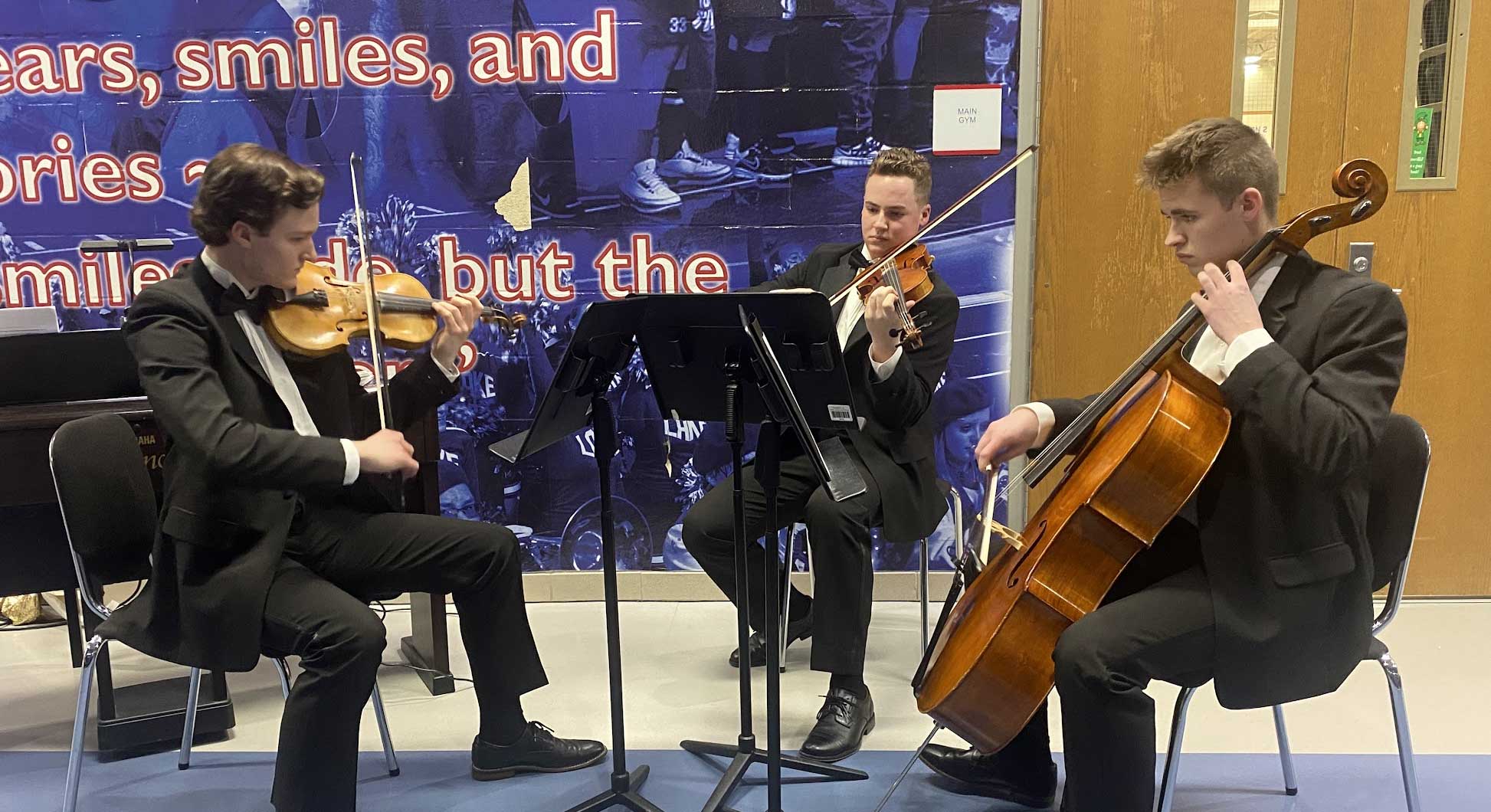©2025 Ohio Music Education Association



My main goal as a string teacher is to put myself out of a job . This may sound odd, but removing ourselves from the instructional process is the only way for our students to become self-sufficient musicians who do not rely on us to fix every performance issue for them. Whether we are teaching one-on-one lessons, coaching a chamber group, or conducting an orchestral ensemble, we do not have the instructional time to point out and fix every error for our students. That method of teaching leads to inefficient rehearsals where our students become reliant on us. Instead, I believe we must teach our students, at all levels, to become their own teachers while in the practice room and during rehearsals. To accomplish that goal, we must teach our students to listen to their own playing so our students develop the ability to identify and fix performance errors without our assistance. This is the only way we can remove ourselves from the learning process.
One of the most common performance issues string teachers constantly address during students’ lessons is poor intonation. To me, the major issue is not our students playing out of tune. It is that our students are not aware they are playing out of tune. This is an issue we must solve as string teachers, and we can help our students achieve the ultimate goal of playing with good intonation if we teach them how to identify and fix their intonation errors through listening and adjusting their pitch starting in the first year of hands-on instruction. However, we can only accomplish this goal if we teach our students to listen and match pitch both vertically (melodically) and horizontally (harmonically) through age-appropriate intonation exercises. If we realize those goals, we will improve our students’ listening skills, speed up their musical development, and create more efficient instructional time where students become less dependent on us to fix their errors.
Below are some of the exercises, both written and call-and-response, I use during lessons to develop my students’ listening skills and their ability to identify and fix intonation errors. While the ideas below are only a small sample of the exercises I use, it is important to note that string teachers can adapt many of these strategies for students at various ages and performance levels. I also suggest having students sing most of the exercises below to increase their audiation skills and their ability to match pitch.
Modulating Scales in Modes
Modulating Scales in Modes
This is a call-and-response exercise where the teacher performs a one-octave scale while using one mode (i.e., Ionian, Dorian, Phrygian, Lydian, Mixolydian, Aeolian and Locrian) while ascending the scale and another mode while descending. During the teacher’s performance, the student listens to the scale and then immediately performs the scale from memory, both ascending and descending, once the teacher completes the scale. For example, the teacher starts on open D and ascends the scale in the Ionian mode and descends in the Aeolian mode. Another example (shown below) has the teacher starting on open D and ascending the scale in the Dorian mode and descending in the Lydian mode. This exercise forces students to listen, identify intervals, identify modes, and adapt their finger patterns based on what they hear.
Young students will initially struggle with this exercise. I suggest scaffolding the exercise into smaller segments so students do not become overwhelmed by having to immediately perform the entire scale. Below is a suggestion for scaffolding the sequence. Use a different mode for each step. I also suggest performing this exercise over a tonic drone so the student has a reference pitch to tune to.
- D tetrachord ascending
- D tetrachord descending
- D tetrachord ascending and descending
- A tetrachord ascending
- A tetrachord descending
- A tetrachord ascending and descending
- One-octave D scale ascending
- One-octave D scale descending
- One-octave D scale ascending and descending
Scale Mountain Climbers
Scale Mountain Climbers
Borrowed from choral warm-ups, this exercise has the student build the scale by adding one note at a time while performing over a tonic drone. The student performs the scale in the following pattern:
- Do
- Do-Re-Do
- Do-Re-Mi-Re-Do
- Do-Re-Mi-Fa-Mi-Re-Do
- Do-Re-Mi-Fa-Sol-Fa-Mi-Re-Do
- Do-Re-Mi-Fa-Sol-La-Sol-Fa-Mi-Re-Do
- Do-Re-Mi-Fa-Sol-La-Ti-La-Sol-Fa-Mi-Re-Do
- Do-Re-Mi-Fa-Sol-La-Ti-Do-Ti-La-Sol-Fa-Mi-Re-Do
- Do
- Do-Ti-Do
- Do-Ti-La-Ti-Do
- Do-Ti-La-Sol-La-Ti-Do
- Do-Ti-La-Sol-Fa-Sol-La-Ti-Do
- Do-Ti-La-Sol-Fa-Mi-Fa-Sol-La-Ti-Do
- Do-Ti-La-Sol-Fa-Mi-Re-Mi-Fa-Sol-La-Ti-Do
- Do-Ti-La-Sol-Fa-Mi-Re-Do-Re-Mi-Fa-Sol-La-Ti-Do
Partner Chase Scale
Partner Chase Scale
During this exercise, a pair of students perform the assigned major or minor scale together. The purpose of this exercise is twofold. The students must first learn how to non-verbally communicate with each other so they match bow speed, bow distribution, bow changes, note changes, balance their parts, and match rhythm throughout this exercise. The second goal is for the student who is playing the scale to adjust their intonation to the tonic note that is being performed by the other student.
For this activity, Student “A” ascends the first octave while Student “B” plays a tonic drone with the same rhythm and bow style. When Student “A” arrives at the end of the first octave, Student “A” stays on the tonic (an octave higher than Student “B”) while Student “B” begins to ascend the scale to meet Student “A” on the octave note. Student “A” begins ascending the second octave of the scale when Student “B” arrives at the octave tonic note that Student “A” was playing. This process of players trading between the scale and tonic notes repeats ascending and descending the scale. This exercises forces students to listen carefully, make fine adjustments to their pitch, and balance the two pitches appropriately (30% scale versus 70% tonic). This activity can be modified for any number of scale octaves. Please see below for a notated version of this exercise in F Major.
Scale Chorales
Scale Chorales
Understanding how pitches relate to each other is vital when developing a student’s ability to listen and adjust their intonation to other musical lines within the ensemble or accompaniment (e.g., bass line, melody, harmony, and countermelody). Scale chorales, as shown below, require the student who is playing the scale to adjust their intonation so they play in tune with the various musical lines. Initially, I suggest having a student play the scale while another performer plays the bass line. Teachers can increase the exercise’s difficulty by changing the line they play with the scale or by increasing the texture by having multiple lines performed at the same time. Another method for increasing difficulty is to flip the exercise and have the teacher perform the scale while the student performs one of the chorale parts. This forces the student to adjust their intonation so they are in tune with the scale. Below an example of a scale chorale in D Major.
Copyright © 2022 by Alfred Music
Create Harmonic Chorales from Repertoire
Create Harmonic Chorales from Repertoire
Use the harmonic structure of chamber or large ensemble repertoire to create a chorale that outlines and slowly builds the piece’s harmonic structure. During this exercise, ensemble members will hear the basic harmonic structure of the piece, how the notes relate to each other, and how the full harmonic structure forms as texture increases. To create the harmonic chorale, students will hold the pitch that occurs on specific beats (not the off beats) for a predetermined duration. For example, below is how I would create various harmonic chorales in a 3/4 time signature and build up to a full performance.
Note: This article was original published in the European String Teachers Association (ESTA) Norway Journal in February 2023. Reprint permission was granted by ESTA Norway.
- Hold the downbeat pitch of each measure as a dotted-half note.
- Hold the pitch on the first beat of each measure as a quarter note and the pitch on the second beat of each measure as half note.
- Hold the pitch on the first beat of each measure as a quarter note, the pitch on the second beat of each measure as a quarter note, and the pitch on the third beat of each measure as a quarter note.
- Have the second violin, viola, cello, and double bass hold the pitch on the first beat of each measure as a dotted-quarter note while first violin (melody) plays their part as written.
- Play the excerpt as written.
Note: This article was original published in the European String Teachers Association (ESTA) Norway Journal in February 2023. Reprint permission was granted by ESTA Norway.

David Pope serves as an Associate Professor of Music Education at Baldwin Wallace University and the current President of the Ohio String Teachers Association. He has presented string pedagogy clinics and his research at the European String Teachers Congress, the ASTA National Conference, The Midwest Clinic, and numerous regional/state conferences. He is the current Editor for the String Research Journal and recently served as a co-editor for Teaching Music Through Performance in Orchestra (Vol. 4) and as a co-author for Sound Orchestra.





